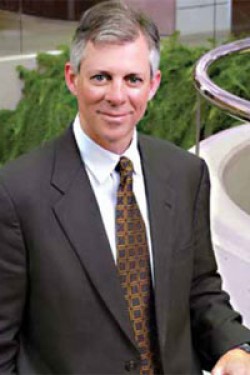The Heart of the Matter: Innovation Ahead for Cardiovascular Care.
The Heart of the Matter: Innovation Ahead for Cardiovascular Care

Robert Robbins, MD, chair of the Department Cardiothoracic Surgery at Stanford University.
To mark American Heart Month, Stanford Hospital & Clinics writer John Sanford sat down with Robert Robbins, MD, chair of the Department of Cardiothoracic Surgery at Stanford University, to discuss innovations in cardiac care and what the future holds.
What are some new minimally invasive procedures you’re excited about?
I think what we’re doing here with aortic valve replacement is a big advance. For people who have aortic valve stenosis, a narrowing of the valve through which blood passes from the left ventricle to the aorta, replacing that valve has traditionally been done through open surgery. This involves cutting through the sternum, putting the patient on a cardiopulmonary bypass machine, stopping the heart and then removing and replacing the valve. It’s a procedure that can take as long as four hours and require two to three months for recovery.
As part of a clinical trial, we’re doing some valve replacements transfemorally — that is, using a catheter to maneuver the new valve through blood vessels to the heart. Only one small incision to the femoral artery is needed, and the procedure generally takes little more than an hour. Recovery time is a few days. We have now done more than a hundred cases, so when the procedure gets FDA approval, which will hopefully happen this year, we’ll be able to hit the ground running. This kind of procedure is already used widely in Europe. It would be especially useful for patients who are high-risk for open surgery, such as older patients and patients with multiple medical problems. About 200,000 people in the United States need aortic valve replacements each year.
Is this cheaper than the surgical approach?
It depends. The cost of the valve is more expensive, but the length of time in the hospital will be reduced, as will recovery time. So I think if you look at it overall, it should eventually reduce the cost of aortic valve replacement.
You’re director of the Stanford Cardiovascular Institute, one of the nation’s top heart-research centers. What are some areas of research you think readers would find compelling?
Certainly, the ability to map the human genome has opened up a whole new realm of possibilities. Much of the work in this area is being done at Stanford, where we have a lot of strength not only in mapping DNA but also interpreting the massive amount of data it produces. Our researchers will be able to create algorithms and ways to manage and interpret this data. One day you’ll probably be able to walk into your doctor’s office and say, “Here’s my genetic code. What does it mean?”
Another great hope is to customize drug therapy to specific cardiovascular diseases, such as hypertension, based on your genetic profile. If your genes make certain proteins or enzymes that metabolize a certain class of drugs better than another class, then doctors could use this so-called pharmacogenomic approach to customize treatments.
The Cardiovascular Institute is also focusing on long-term health. In the future, physicians are going to be paid for delivering the highest quality care at the lowest cost, so there’s a transition under way from diagnosing and treating conditions, which Stanford is very good at, to predicting and preventing. One of the really important areas is going to be how we can get people to change their behavior, so the focus becomes promoting health rather than treating disease.
Does Stanford Hospital have any such prevention programs in the works?
We’re developing a program called the Cardinal Commitment, which we will likely roll out in phases. The basic principle is that we would work with patients and leverage information and wireless technology to help us manage their heart health. This might include biometrics, such as checking their blood pressure and pulse, which could be transmitted back to a central processing center for monitoring. If you can imagine having a muse or a life coach tethered at the other end of the electronic data fields, helping you to manage your cardiovascular health — that’s the idea.
What role could stem cells one day play in new therapies?
I think they hold huge promise, but we’re not ready yet to employ stem-cell therapies to treat end-stage heart failure. But I do believe our group here at Stanford, one of the world’s leaders in this area, will be the first to put embryonic stem cells into the human heart.
By John Sanford
Stanford University Medical Center
###
> About Stanford Hospital & Clinics
Stanford Hospital & Clinics is known worldwide for advanced treatment of complex disorders in areas such as cardiovascular care, cancer treatment, neurosciences, surgery, and organ transplants. It is currently ranked No. 17 on the U.S. News & World Report’s “America’s Best Hospitals” list and No. 1 in the San Jose Metropolitan area. Stanford Hospital & Clinics is internationally recognized for translating medical breakthroughs into the care of patients.
###
* Stanford University Medical Center integrates research, medical education and patient care at its three institutions – Stanford University School of Medicine, Stanford Hospital & Clinics and Lucile Packard Children’s Hospital.
** The above story is adapted from materials provided by Stanford University School of Medicine
________________________________________________________________




















